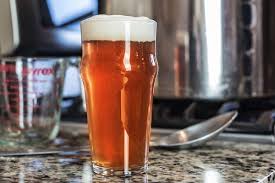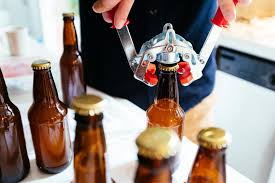Good Home-Brewed Beer – Home Brewing Kits
Home brewing kits may be helpful not just to the individual who uses them to produce his own product, but also to the country and the environment in general. The time has come to decentralize industry and individuals will make that possible faster by trying to make products instead of purchasing stuff.
You continue to invest on something you can’t create and that’s why people in the past have become more involved in manufacturing products than in making tons of money. Do you want to learn more? Visit homebrew ireland
Your brewing package will come with a beer blend
 While buying mixes goes against the self-reliance theory, it is justified in this situation. The first explanation is that it will take a specialist to combine the products and the second is that the raw ingredients may not always be found easily in supermarkets.
While buying mixes goes against the self-reliance theory, it is justified in this situation. The first explanation is that it will take a specialist to combine the products and the second is that the raw ingredients may not always be found easily in supermarkets.
Brew blends contain 4 main ingredients in home brewing kits
Malt is the source of the sugar required for the beer to contain alcohol. Malts are produced from rice , wheat, or barley. The grains are first soaked in water to make malt. When they begin to germinate, they are extracted and transferred for processing to a kiln drier.
Water is needed to extract sugar from alcohol. Without that, the mix’s components are essentially inert. The type of water used may also change the beer’s taste, either to improve or ruin it. The brew blends are usually dissolved in a small amount of water.
Hops are fragrances based on oil, derived from flowers and/or herbs. Such ingredients are responsible for the beer’s characteristic aroma. Because of their sticky origin they often help to protect beer from the action of bacteria.
Yeast catalyzes the alcohol changeover from oil. It is converted in the phase itself, which brings the beer some of its characteristics. The amount of yeast used for fermentation thus influences the type of beer it will result in. Lager yeast is used for wine, ale, and lager beer.
Preparation for fermentation of the home brewing kits
When you want to get good results, the directions written on the box about the proportion of water to be added to the mix should be followed to the letter.

Fermentation boats are a must for home brewing kits
When correctly blended, you can automatically poure the home brewing kits beer mixture into the container for fermentation which you should get with the home brewing package. Such containers are either made of glass or plastic. The protection may be a protective cork or an implanted air lock into a bung or grommet. Once in, seal the liquid using the plug which comes with the bottle.
In a few days, you’ve got beer with home brewing kits
You should expect to taste the drink made with home brewing kits in a couple of days, and if you followed the directions carefully in the beer mix box.
Home Brewing – Basics
If you’re investigating online home brewing, you might be a little overwhelmed with all of the details. There’s no need to say though that home brewing is too hard. If you practice and follow the right basic steps, then at your first attempts you can quickly produce good batches of beer. To help you get started on the right path, here are five simple steps you can use to lead you and get you interested in this enjoyable and fulfilling activity right away. Have a look at home brew for more info on this.
 First, you’ll need supplies for the home brewing. There are many choices here but two primary options are available to make things easy to get started. You can purchase an all-in-one package (like a Mr. Brew or The Beer Machine), or you can buy a set consisting of all the necessary pieces of equipment that you need to brew. Both of these choices aren’t too expensive — either way, for under $100 you can practically get home brewing going. The part packages will include the main equipment you require, and the all-in-one kits are self-contained and ready to brew beer.
First, you’ll need supplies for the home brewing. There are many choices here but two primary options are available to make things easy to get started. You can purchase an all-in-one package (like a Mr. Brew or The Beer Machine), or you can buy a set consisting of all the necessary pieces of equipment that you need to brew. Both of these choices aren’t too expensive — either way, for under $100 you can practically get home brewing going. The part packages will include the main equipment you require, and the all-in-one kits are self-contained and ready to brew beer.
Next, you need compounds. Beginning home brewing product kits exist to make the method stripped and simplified — you must first learn the basics of the home brewing process. Once you have that concept, you will know how to use different ingredients and use different techniques in an attempt to exert better control over the final product.
But at first, you basically have to be able to make beer in the easiest way. Ingredient kits include what you need to brew beer-just drop all the supplies in your brew kettle, cook, and you’re on the way! The brewing kits should come with all the essential ingredients needed to make beer — malt extract, which typically comes pre-hopped (and you don’t have to think about adding hops), and yeast, so all you need to add is sugar. Such kits also have guidance on how long to boil and how to turn this wort into beer.
The home brewing process starts with first ensuring all of the home brewing equipment is properly cleaned and sanitized — these are not the same. Cleaning and sanitizing are two different measures but both steps must be taken to insure that bacteria and germs do not contaminate the product. The beer brewing begins with the boil, following sufficient cleaning and sanitizing.
Usually, you’ll bring the water up to 160 degrees F in your brew pot, and extract the water from the heat so it won’t get too heavy. You then mix the ingredients from the package and combine to blend in as instructed. You have now created what’s known as the wort, and finally this will become your brew. You’ll want to make sure all of the components have been processed and fully incorporated. You first attach the wort to the fermenter, and transfer the top off water to the fermenter to have a 5 gallon sample of wort in it.
 This begins the process of fermentation, which is the process of turning the wort into beer. Fermentation will occur for 7-10 days, and one key factor for fermentation during the fermentation period is monitoring and maintaining proper temperature. How do you know when fermentation finishes? You can see from visual indications such as slowing down or stopping the operation on the airlock.
This begins the process of fermentation, which is the process of turning the wort into beer. Fermentation will occur for 7-10 days, and one key factor for fermentation during the fermentation period is monitoring and maintaining proper temperature. How do you know when fermentation finishes? You can see from visual indications such as slowing down or stopping the operation on the airlock.
Physical signs are not always foolish evidence, though, and it is better not to rely on them as the primary means of determining when fermentation takes place. Specific gravity calculations should also be performed with a hydrometer. If you don’t change your SG readings for a few consecutive days, then you realize fermentation is complete. When your SG does not shift for a couple of days, but it’s not near to your final gravity goal, so you realize you have a stuck fermentation — this means fermentation is not full, so careful steps must be taken to insure fermentation is complete.
Eventually, until fermentation is complete, it’s time for bottling and prime. Priming is the act of applying sugar before bottling the beer — this additional sugar feeds the yeast and produces carbonation. You should add the sugar to each actual glass, however in the bottling bucket several home brewers add the sugar to the beer and swirl it to dissolve fully. Once the sugar has been fully incorporated, you are ready to transfer the beer into the bottles.
Home Brewing Tips For Making Better Beer
 This is a pretty simple job to have the tools and supplies equipped for home brewing. The home brewing process is also fairly simple. Making good beer is not too hard either, and these are the reasons why home brewing is so common. Getting home brewing going doesn’t require a big cost, so there are no big obstacles to getting started. And once you actually get to sample that first batch of beer you’ll probably be hooked on a passion that millions of home brewers love.
This is a pretty simple job to have the tools and supplies equipped for home brewing. The home brewing process is also fairly simple. Making good beer is not too hard either, and these are the reasons why home brewing is so common. Getting home brewing going doesn’t require a big cost, so there are no big obstacles to getting started. And once you actually get to sample that first batch of beer you’ll probably be hooked on a passion that millions of home brewers love.
Ale making is one aspect, and good beer making is another. How difficult is it to make good beer, then? The key point of your first few batches is to learn the basic method of home brewing properly. You ‘re not trying to make a great beer this time. You will take fire to create a drinkable brew. In your first few batches you’ll probably notice defects, and that’s natural. Could be the drink too sour. It might not be as straightforward as you’d hoped. No matter what, there are flaws, particularly when you get started first. It’s part of curve thinking. Furthermore, you learn from your mistakes (hopefully) and this leads to better brew. Such mistakes can motivate you to make beer great.
You’ll also find that while the standard kits of starter supplies that bring so many people to home brewing do not make the best beer, there are some easy modifications that you can do that will enhance your beer. Giving good beer on your first few attempts isn’t too hard. You just have to understand that there will be errors and your first few samples won’t be the best. Keep in mind that you’re just trying to make it drinkable, and you’re studying how to get better at this art.
 There’s no need to be upset if the first few attempts are not to produce amazing brew. Eventually you’re going to learn how to make amazing brew. Before that, though, you will learn how to make better beer, then great beer. But if you’re continuing to try to explore on-line home brewing, you’ll get there sooner rather than later. Linking with other brewers will teach you trade tricks. Before you make them, you’ll learn how to avoid common mistakes, and what to do if you make those mistakes so that your beer isn’t ruined. That will serve to reduce the curve of learning.
There’s no need to be upset if the first few attempts are not to produce amazing brew. Eventually you’re going to learn how to make amazing brew. Before that, though, you will learn how to make better beer, then great beer. But if you’re continuing to try to explore on-line home brewing, you’ll get there sooner rather than later. Linking with other brewers will teach you trade tricks. Before you make them, you’ll learn how to avoid common mistakes, and what to do if you make those mistakes so that your beer isn’t ruined. That will serve to reduce the curve of learning.



